
好的,我现在需要帮用户总结这篇文章的内容,控制在100字以内。首先,我得通读全文,抓住主要信息。 文章主要讲中东地区的数字化转型和网络安全问题。提到沙特、科威特和阿联酋的国家计划推动了各个行业的现代化。但随着数字化进程加快,网络威胁也在增加,导致网络安全成为重点。 接着,文章提到中东的网络安全市场在2025年价值167.5亿美元,预计到2030年达到260.4亿美元,年复合增长率9.2%。平均每次攻击的成本高达746万美元,这在全球范围内都很高。 然后,文章分析了中东地区企业面临的挑战:大多数企业使用8-12个不连通的安全工具,管理多个仪表盘,聘请多个合规顾问,每天处理超过200个警报。尽管每年在网络安全上投入2-5百万美元,但很多企业仍然容易受到攻击且不符合规定。 接下来是推动增长的四个趋势:Vision 2030和2035计划加速AI、IoT和自动化;快速向云迁移;扩展合规要求;智能城市生态系统连接大量设备。 按行业来看,金融服务业占27%,其次是政府、能源与公共事业等。每个行业都有独特的风险,但共同的目标是通过情报实现韧性。 威胁方面包括APT、勒索软件即服务、云配置错误、内部威胁和钓鱼攻击等。最后介绍了Seceon公司的解决方案及其在中东的优势。 现在我需要把这些信息浓缩到100字以内。重点包括:中东数字化转型快速进行,带来网络安全挑战;市场增长情况;企业面临的问题和趋势;Seceon的解决方案。 所以总结应该是:中东正经历快速数字化转型,在推动各行业现代化的同时面临日益增长的网络威胁。网络安全市场预计到2030年达到260亿美元。企业面临复杂的安全工具和合规问题。Seceon通过统一平台简化安全和合规。 </think> 中东地区正经历快速数字化转型,在推动各行业现代化的同时面临日益增长的网络威胁。网络安全市场预计到2030年达到260亿美元规模。企业普遍面临复杂的安全工具和合规挑战。Seceon通过统一平台简化安全与合规流程,助力实现数字主权与韧性目标。 2025-10-24 17:21:0 Author: securityboulevard.com(查看原文) 阅读量:5 收藏
The Middle East is undergoing one of the fastest digital transformations in the world. National initiatives such as Saudi Vision 2030, Kuwait Vision 2035, and the UAE Digital Government Strategy are fueling large-scale modernization across every sector. However, as this progress accelerates, the region faces a parallel rise in cyber threats, pushing cybersecurity to the forefront of national and enterprise priorities.
The Middle East cybersecurity market is valued at $16.75 billion (2025) and projected to reach $26.04 billion by 2030, growing at a 9.2% CAGR. The average breach cost has reached $7.46 million, one of the highest globally, a reminder that digital advancement must be matched by strong, adaptive cyber defenses.
Digital Growth Meets New Threat Realities
A recent analysis of 50+ Middle East organizations revealed a troubling pattern – most enterprises operate with 8-12 disconnected security tools, manage three dashboards, retain two compliance consultants, and still face over 200 daily alerts. Despite spending $2-5 million annually on cybersecurity, many remain vulnerable and non-compliant even after 18 months.
The region’s growth is being driven by four major trends:
- Vision 2030 & 2035 initiatives are accelerating the adoption of AI, IoT, and automation.
- Rapid cloud migration to AWS, Azure, and GCP environments.
- Expanding compliance mandates across BFSI, telecom, and energy sectors.
- Smart city ecosystems are connecting millions of devices and expanding attack surfaces.
By industry share, BFSI (27%) leads in cybersecurity investment, followed by Government (21%), Energy & Utilities (18%), Healthcare (14%), Manufacturing (12%), and others. Each sector faces unique risks, but all share one common goal – achieving resilience through intelligence.
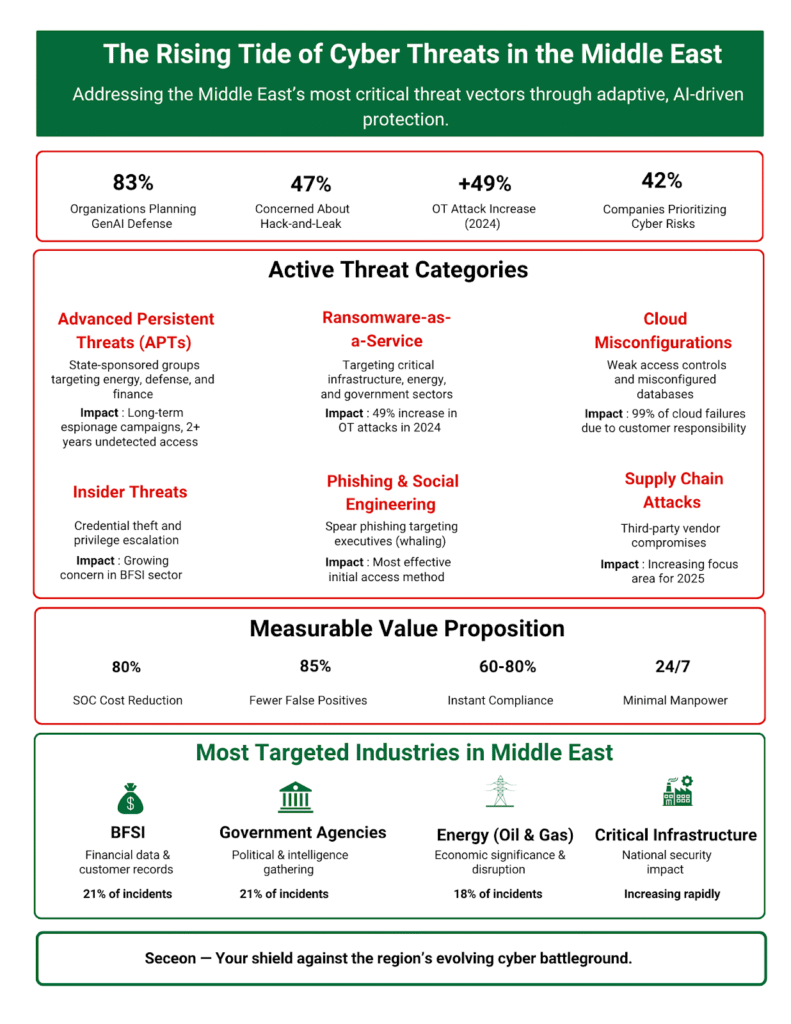
Evolving Threat Landscape
As digital ecosystems grow, so does the threat exposure. 83% of organizations admit struggling to keep pace with the evolving landscape, while OT attacks surged 49% in 2024, especially against energy and utilities. 47% of enterprises cite data leakage as a top concern, and 42% now treat cyber risk as a board-level issue.
Top active threats include:
- Advanced Persistent Threats (APTs): targeting defense, energy, and government sectors.
- Ransomware-as-a-Service (RaaS): disrupting critical infrastructure and financial institutions.
- Cloud Misconfigurations: responsible for 90% of cloud breaches.
- Insider Threats & Credential Abuse: rising across BFSI and telecom.
- Phishing & Social Engineering: the most common entry point.
- Supply Chain Attacks: exploiting third-party vendor ecosystems.
One CISO in Dubai summarized the regional frustration:
“We spent $3 million on tools, we’re still not compliant with SAMA, we still got breached, and my team is exhausted.”
This isn’t a tool problem; it’s an architecture problem. Attackers exploit the gaps between systems, while security teams drown in noise instead of intelligence.
Navigating Regional Compliance Challenges
The Middle East’s cybersecurity frameworks are among the most dynamic in the world. Each nation enforces its own controls while aligning with global standards like ISO 27001, PCI-DSS, GDPR, HIPAA, SOC 2, NIST, and CMMC 2.0.
- Saudi Arabia mandates SAMA, NCA ECC, and CITC frameworks.
- The UAE enforces IAS, NESA, and DFSA regulations.
- Qatar follows the Central Bank and MOICT frameworks.
- Kuwait aligns with CITRA and Vision 2035 guidelines.
- Bahrain enforces its Cloud First Policy and National Cyber Framework, while Oman follows TRA and CBO mandates.
While these policies have strengthened regional resilience, compliance remains time-consuming, averaging 6-12 months. Traditional GRC approaches can’t keep up with today’s regulatory speed.
Seceon: Simplifying Security, Compliance, and Intelligence
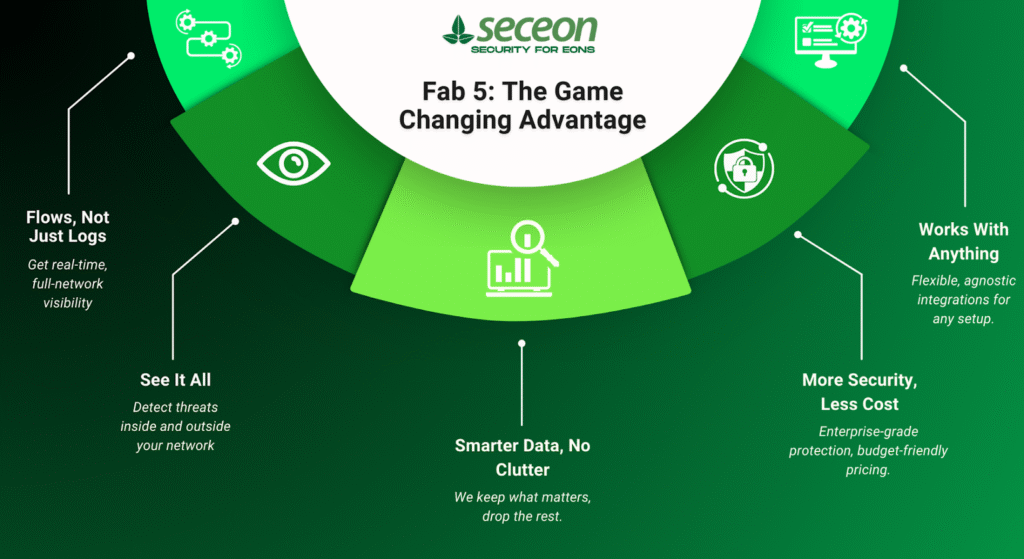
Seceon addresses this challenge with its AI-driven unified platform, eliminating tool sprawl and replacing silos with intelligence. It merges threat detection, response automation, and compliance validation into a single, intelligent ecosystem.
aiSecurity BI360
A compliance analytics platform offering deep insights, real-time dashboards, and automated audits. Supports CMMC, HIPAA, PCI-DSS, NIST, and GDPR, helping organizations achieve 72% faster compliance readiness while cutting audit fatigue.
aiBAS360
An AI-powered Breach & Attack Simulation engine that continuously tests and validates defenses. Provides risk scoring, SIEM integration, and executive summaries, used by 55% of enterprises to quantify and improve cyber posture.
CGuard 2.0
A cloud-native protection suite combining CWPP, CSPM, and CNAPP capabilities. Delivers multi-cloud visibility, automated remediation, and Kubernetes-native security, mitigating 90% of misconfiguration-based risks.
aiSIEM
A next-generation AI-driven SIEM that replaces rule-based detection with machine learning, correlating events across IT, OT, and cloud environments in real time.
aiXDR-PMax
Provides end-to-end protection for endpoints, networks, and cloud workloads, ensuring unified visibility across the enterprise.
aiSecOT360
Built for the Middle East’s expanding OT security market ($442M → $1.46B by 2031), it protects industrial control and SCADA environments from sophisticated attacks.
aiCompliance CMX360
Delivers instant compliance readiness (60-80%) for SAMA, NCA, and 18+ global frameworks, reducing compliance cycles from months to weeks.
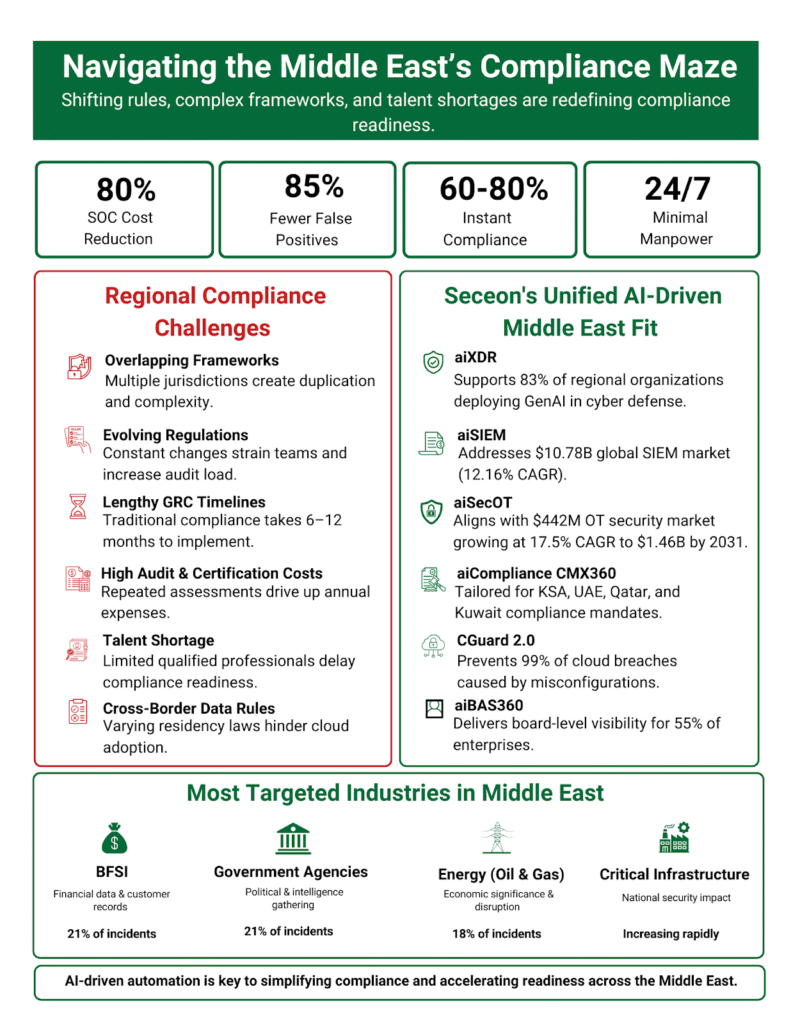
Seceon’s Edge in the Middle East
Seceon’s unified architecture replaces complexity with clarity. Customers typically achieve:
- 80% SOC cost reduction through automation
- 85% fewer false positives via AI correlation
- 60-80% faster compliance through automation
- 24×7 coverage with minimal human dependency
Its regional advantage includes native support for SAMA, NCA, NESA, and CITRA frameworks and deep partnerships with Tech First Gulf (TFG) and AZCOM IT Distribution, ensuring localized deployment and support. Its AI-native design aligns perfectly with the region’s move toward GenAI adoption as 83% of Middle East organizations now leverage AI for cyber defense.
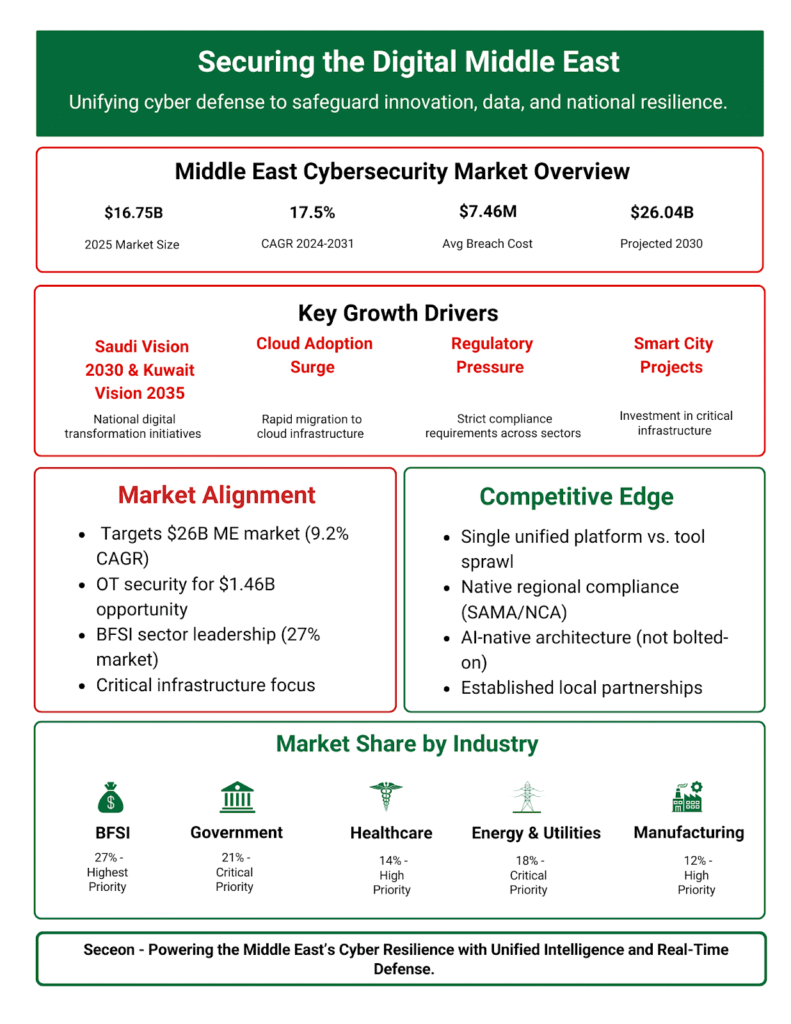
Securing Operational Technology (OT)
With digital transformation reaching into energy, oil, and utilities, OT security has become critical.
Seceon’s OT suite bridges IT and OT with:
- Real-time asset discovery and anomaly detection
- Unified visibility across converged systems
- Predictive analytics reduces downtime by up to 50%
By integrating IT-OT convergence, Seceon enables resilient protection for the industries powering Vision 2030.
Impact Across Industries
- Banking & Finance: 90% fewer false positives, multi-million cost savings, full SAMA compliance.
- Energy & Utilities: 50% downtime reduction, unified OT visibility, automated compliance.
- Government: Automated reporting, 20+ framework alignment, and real-time audit metrics.
Seceon delivers measurable outcomes, simplifying security while enhancing resilience.
Why Seceon Matters Now
The Middle East cybersecurity market is on track to hit $26 billion by 2030. Two kinds of organizations are emerging:
1. Those managing 15+ tools, overwhelmed by complexity and cost.
2. Those adopting unified, AI-driven platforms that simplify, automate, and protect.
Seceon helps enterprises shift from reactive defense to proactive intelligence aligning with the region’s drive for digital sovereignty and cyber self-reliance.
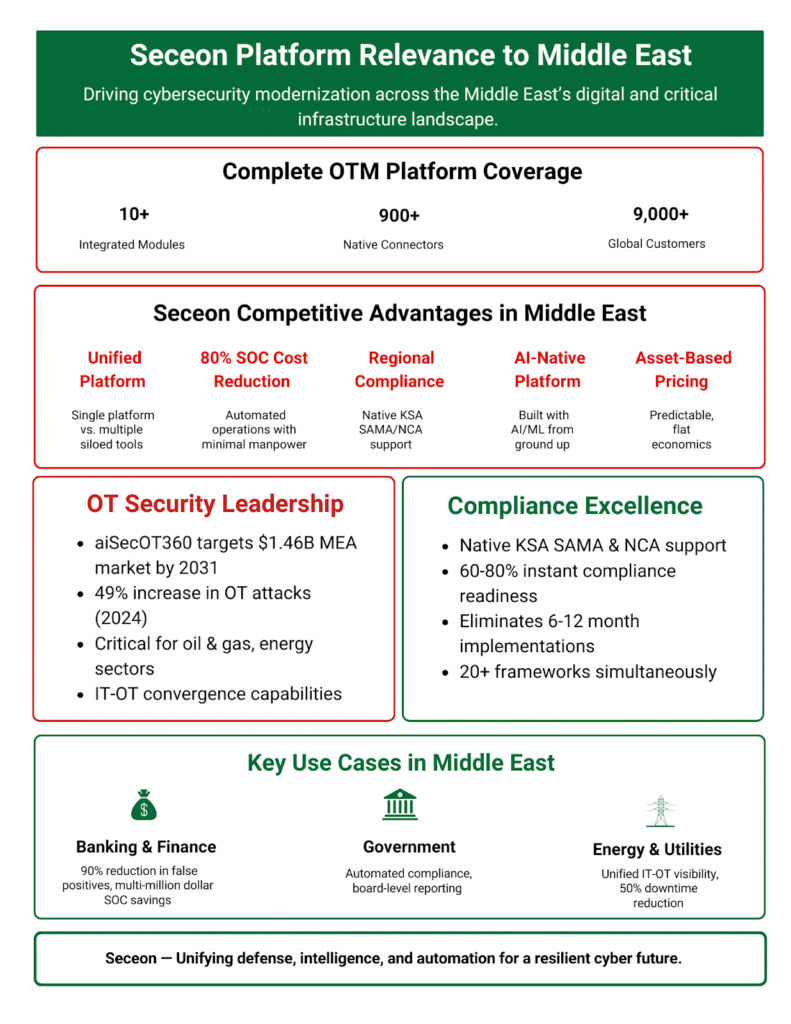
Conclusion: Building a Secure Digital Future
Threat groups like APT33 and APT34 don’t use ten tools; they use one coordinated strategy. Defenders must do the same. The future belongs to organizations that unify their defenses, automate compliance, and build intelligence into their core.
Through platforms like aiSecurity BI360, aiBAS360, CGuard 2.0, aiSIEM, aiSecOT360, and aiCompliance CMX360, and strong partnerships with TFG and AZCOM IT Distribution Seceon is helping enterprises across the Middle East achieve true cyber resilience.
The question isn’t whether to modernize, it’s whether your organization will lead the transition or react to the breach.
The post Middle East Cyber Resilience 2030: Unified Defense in a $26B Market appeared first on Seceon Inc.
*** This is a Security Bloggers Network syndicated blog from Seceon Inc authored by Pushpendra Mishra. Read the original post at: https://seceon.com/middle-east-cyber-resilience-2030-unified-defense-in-a-26b-market/
如有侵权请联系:admin#unsafe.sh
